The paver blocks market is estimated to be valued at USD 4.8 billion in 2025 and is projected to reach USD 7.9 billion by 2035, registering a compound annual growth rate (CAGR) of 5.0% over the forecast period.
This growth is fueled by increased demand for durable and aesthetically pleasing outdoor surfaces in both residential and commercial applications. The construction industry's ongoing focus on high-quality, low-maintenance materials further supports the rising preference for paver blocks. Emerging economies, with rapidly developing infrastructure, contribute significantly to the growing market demand. Rising construction activities, particularly in the development of roads, pedestrian walkways, and landscaping projects, play a vital role in driving the market’s growth trajectory.
As urban areas continue to expand, the necessity for cost-effective, long-lasting paving solutions is becoming more apparent. Competitive pricing and varied design options have positioned paver blocks as an attractive choice for developers and contractors alike. Additionally, increasing government investments in public infrastructure projects across both emerging and developed economies are expected to reinforce market demand, driving growth throughout the forecast period.
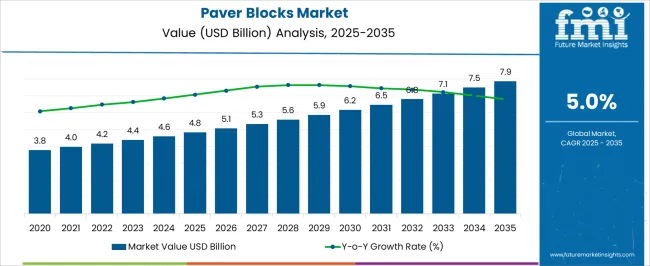
| Metric | Value |
|---|---|
| Paver Blocks Market Estimated Value in (2025 E) | USD 4.8 billion |
| Paver Blocks Market Forecast Value in (2035 F) | USD 7.9 billion |
| Forecast CAGR (2025 to 2035) | 5.0% |
The paver blocks market represents a niche but important segment within several parent markets. In the construction materials market, it holds about 2-3%, driven by the growing demand for durable and aesthetically pleasing materials in various residential and commercial projects. In the landscaping products market, paver blocks account for around 1-2%, as they are increasingly used for outdoor pavings like walkways and gardens.
Within the concrete products market, they command roughly 4-5%, reflecting their importance as a sub-segment in outdoor applications. Paver blocks also contribute around 2-3% to the building materials market, particularly for developers seeking functional yet decorative solutions. In the infrastructure development sector, they hold an estimated 3-4% share, favored for use in roadways, public spaces, and urban development projects.
The market is experiencing sustained growth, supported by rising infrastructure investments and the growing preference for durable, aesthetically versatile outdoor surfacing solutions. Demand is being driven by increasing urban development, expansion of residential and commercial landscapes, and a growing emphasis on sustainable construction practices.
Technological advancements in manufacturing have enabled the production of high-strength, weather-resistant blocks with diverse textures and designs, enhancing their appeal across multiple applications. The market is also benefiting from stricter government regulations on quality standards and an emphasis on eco-friendly materials, further encouraging adoption.
As urbanization accelerates and property developers focus on enhancing functional and visual aspects of outdoor spaces, paver blocks are being integrated into roads, walkways, patios, and landscaped areas at an increasing pace Long-term growth prospects are reinforced by public infrastructure upgrades, the rising popularity of modular and interlocking designs, and the low maintenance and cost efficiency associated with paver block installations.
The paver blocks market is segmented by material, application, end use, distribution channel, and geographic regions. By material, paver blocks market is divided into concrete, clay, permeable, stone, and others (rubber, etc.). In terms of application, paver blocks market is classified into hardscaping, structural, siding, fireplace, and others (pavement, etc.). Based on end use, paver blocks market is segmented into residential, commercial, and industrial. By distribution channel, paver blocks market is segmented into direct and indirect. Regionally, the paver blocks industry is classified into North America, Latin America, Western Europe, Eastern Europe, Balkan & Baltic Countries, Russia & Belarus, Central Asia, East Asia, South Asia & Pacific, and the Middle East & Africa.
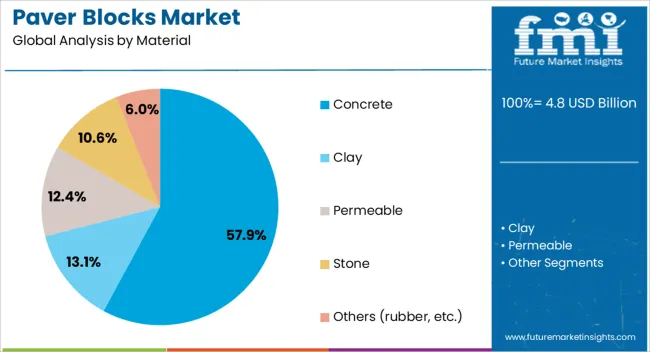
The concrete material segment is projected to hold 57.90% of the market revenue share in 2025, making it the leading material type. This leadership is attributed to concrete’s high strength, cost-effectiveness, and adaptability in diverse climatic conditions. The segment’s growth has been supported by its ability to be molded into a wide range of shapes, sizes, and finishes, enabling customization for residential, commercial, and public infrastructure projects.
Concrete paver blocks are known for their durability and load-bearing capacity, making them suitable for high-traffic areas while retaining aesthetic appeal. Production efficiency and the availability of raw materials at competitive costs have further enhanced their market presence.
The material’s compatibility with modern manufacturing techniques, including colored and textured surface treatments, has expanded its use in both functional and decorative applications As construction activities rise globally, the demand for long-lasting, versatile, and economical paving materials has continued to strengthen the concrete segment’s dominant position.
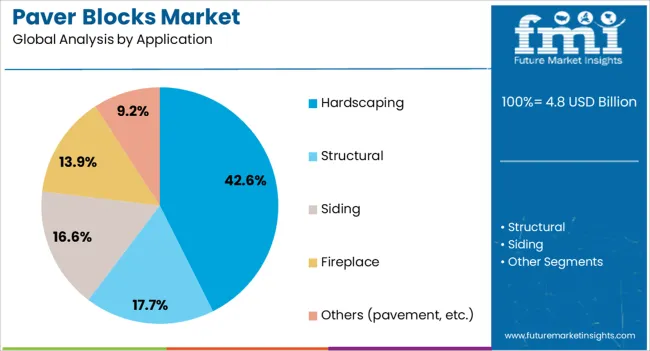
The hardscaping application segment is anticipated to account for 42.60% of the market revenue share in 2025, emerging as the leading application area. This prominence has been driven by the growing emphasis on enhancing outdoor living spaces and improving landscape functionality in both residential and commercial projects. Paver blocks in hardscaping are being widely used for patios, garden pathways, driveways, and public parks due to their design flexibility and long-term durability.
The ease of installation and maintenance, along with the capacity for modular arrangements, has contributed to their preference over traditional surfacing options. Increased consumer interest in property value enhancement and outdoor aesthetics has further propelled demand in this segment.
Additionally, municipal and urban development projects focusing on beautification and pedestrian-friendly infrastructure have accelerated the integration of paver blocks in hardscaping With a trend toward sustainable and low-maintenance landscaping solutions, this segment is expected to maintain its strong market position.
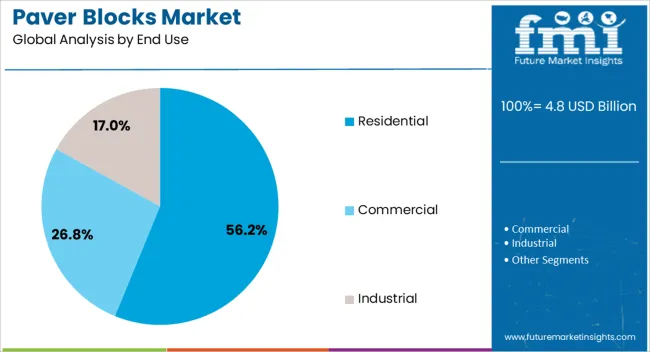
The residential end use segment is expected to hold 56.20% of the market revenue share in 2025, establishing itself as the dominant end-use category. Growth in this segment has been influenced by the rising popularity of outdoor living spaces, home improvement trends, and the demand for visually appealing yet functional surfacing solutions.
Residential applications, including driveways, walkways, patios, and garden pathways, have seen increasing adoption of paver blocks due to their ease of installation, durability, and customizability. The ability to choose from various colors, patterns, and textures allows homeowners to align paver designs with architectural styles, enhancing property aesthetics and value.
Additionally, the low maintenance requirements and long service life of paver blocks have made them a preferred choice in residential landscaping projects Urban housing developments, gated communities, and premium housing projects have particularly driven demand, while growing awareness of sustainable construction materials is further supporting the segment’s leadership in the overall market.
The global paver blocks market is poised for growth, with rising demand driven by increasing construction and infrastructure development. Emerging opportunities lie in the adoption of eco-friendly and permeable solutions, while customization trends are gaining traction in both residential and commercial sectors. However, challenges such as fluctuating raw material prices and competition from alternative materials remain. With strategic innovations and government support, the market holds substantial potential for expansion across various regions.
The demand for paver blocks is primarily influenced by the expanding infrastructure sector, especially in residential, commercial, and urban development projects. Paver blocks are sought for their durability, versatility, and aesthetic appeal in pathways, driveways, and roads. Their ability to withstand varying weather conditions and ease of maintenance makes them a preferred choice. As infrastructure projects intensify across emerging markets, the need for cost-effective, long-lasting paving solutions rises, which is boosting the market demand significantly. Regional players are focused on ensuring high-quality production to meet the growing construction needs.
Growing emphasis on eco-friendly materials has created opportunities for the paver blocks market, with many players exploring sustainable alternatives such as recycled and permeable paver blocks. These options not only cater to the demand for energy-efficient building solutions but also contribute to reducing environmental impact in construction activities. Additionally, government-led initiatives promoting sustainable infrastructure and the increased preference for modular construction techniques are expected to further drive the adoption of paver blocks in upcoming projects. The market also sees potential in expanding product lines to cater to varied architectural preferences.
The current trend in the paver blocks market leans toward the customization of designs, colors, and sizes to align with modern architectural aesthetics. In particular, demand for interlocking paver blocks is on the rise due to their high structural integrity and ease of installation. There is also a notable increase in the use of permeable pavers in urban planning for water management, promoting stormwater retention and reducing runoff. The integration of advanced manufacturing technologies is streamlining production processes, reducing costs, and enhancing product quality, thereby catering to the growing demand for high-performance paving materials.
Despite the growth prospects, the paver blocks market faces challenges such as the volatility of raw material prices, particularly for cement and aggregates. Manufacturers must also address the competition from alternative materials like asphalt and concrete, which are often preferred for large-scale projects due to cost-effectiveness and easy availability. Furthermore, the market’s growth is hindered by the regional disparities in demand, where developing regions may face hurdles in terms of skilled labor availability and supply chain complexities. Overcoming these challenges is essential to maintaining steady market progression.

| Country | CAGR |
|---|---|
| China | 6.8% |
| India | 6.3% |
| Germany | 5.8% |
| France | 5.3% |
| UK | 4.8% |
| USA | 4.3% |
| Brazil | 3.8% |
| China | 18.1% |
| India | 16.8% |
| Germany | 15.4% |
| France | 14.1% |
| UK | 12.7% |
| USA | 11.4% |
| Brazil | 10.1% |
The global paver blocks market is projected to grow at a 5% CAGR from 2025 to 2035. China leads with a growth rate of 6.8%, followed by India at 6.3%, and Germany at 5.8%. The United Kingdom records a growth rate of 4.8%, while the United States shows the slowest growth at 4.3%. These varying growth rates are influenced by the increasing demand for durable and aesthetically appealing construction materials, particularly in urban development projects. Emerging markets like China and India are seeing higher growth rates due to rapid infrastructure development and urbanization, while more mature markets like the USA and the UK experience steady growth driven by strong demand for sustainable and eco-friendly construction solutions. Regional trends also indicate a growing interest in sustainable and high-performance paving materials across all sectors. This report includes insights on 40+ countries; the top markets are shown here for reference.
The paver blocks market in China is expected to grow at a CAGR of 6.8%. China’s rapid urbanization, infrastructure expansion, and increasing focus on quality construction materials are driving the demand for paver blocks. The growing need for durable and aesthetically pleasing paving solutions in urban development and public spaces is fueling market growth. Furthermore, government initiatives and investments in urban infrastructure projects, including roads, parks, and commercial spaces, continue to support this demand. The increasing focus on sustainability in the construction sector also accelerates the adoption of eco-friendly paving materials, providing further opportunities for growth.
The paver blocks market in India is projected to grow at a CAGR of 6.3%. India’s growing population and rapid urbanization are fueling demand for durable and cost-effective paving solutions, particularly in road construction and residential developments. The government’s focus on improving infrastructure, including highways, residential areas, and public spaces, continues to drive the market. Additionally, the increased awareness of the aesthetic and functional benefits of paver blocks in landscaping and commercial spaces contributes to market growth. As urban centers expand, the demand for high-performance and visually appealing paving materials increases, further stimulating market demand.
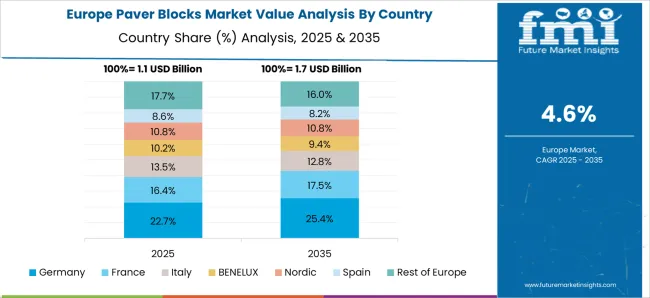
The paver blocks market in Germany is expected to grow at a CAGR of 5.8%. Germany’s well-established infrastructure development and commitment to sustainable construction practices are key drivers of this market. The increasing use of paver blocks in urban development projects, such as roads, sidewalks, and public squares, continues to support growth. Additionally, Germany’s strict environmental regulations and emphasis on reducing the environmental impact of construction materials are driving the adoption of eco-friendly paving solutions, including recycled and sustainable paver blocks. The demand for high-performance and long-lasting paving materials remains strong as urban areas expand.
The paver blocks market in the United Kingdom is projected to grow at a CAGR of 4.8%. The demand for paver blocks in the UK is being driven by a growing preference for durable, sustainable, and aesthetically pleasing paving solutions in urban and suburban areas. Increasing construction activities, including residential, commercial, and public space developments, further fuel market growth. Additionally, the UK’s commitment to reducing carbon emissions and promoting sustainable construction materials is supporting the adoption of eco-friendly paver blocks. As demand for sustainable urban infrastructure rises, the UK is witnessing steady growth in the market.
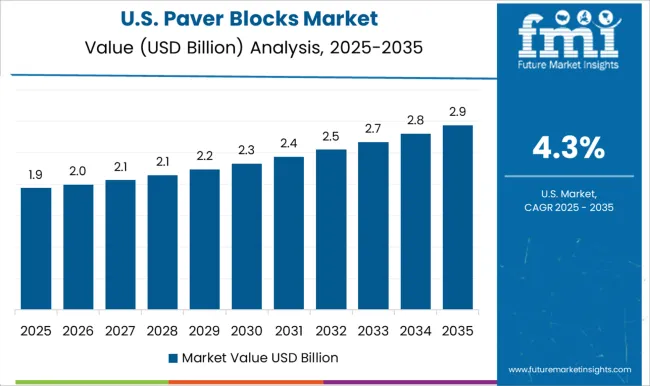
The paver blocks market in the United States is expected to grow at a CAGR of 4.3%. The demand for paver blocks in the USA is driven by increasing urbanization and infrastructure development, particularly in road construction, landscaping, and public space improvement projects. The growing interest in sustainable construction materials, including paver blocks made from recycled and eco-friendly materials, is another key factor contributing to market growth. As the USA continues to invest in infrastructure modernization and environmentally conscious building practices, the paver blocks market is poised for steady growth.
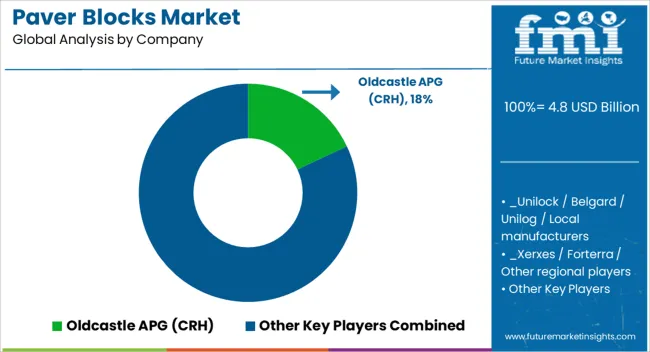
The paver blocks market is characterized by significant competition, with key players such as Oldcastle APG (CRH), Unilock, Belgard, Unilog, Xerxes, and Forterra dominating the industry. Oldcastle APG, a subsidiary of CRH, stands out with its extensive range of paving solutions, including concrete and interlocking pavers. The company leverages its established presence and strong distribution networks to maintain its leadership position in North America. Similarly, Unilock and Belgard offer a variety of high-quality paver blocks, focusing on aesthetics and durability. These brands are renowned for their wide product portfolios, designed to cater to both residential and commercial applications. Forterra, a prominent player in the paver blocks industry, focuses on sustainable and cost-effective solutions, capitalizing on growing demand for eco-friendly construction materials. Its products are widely adopted in urban infrastructure projects, providing functional yet aesthetically pleasing paving options.
Meanwhile, Xerxes and Unilog are gaining market share through strategic innovations and specialized offerings that meet the needs of niche markets, such as custom design pavers for high-end developments. The competitive landscape is shaped by product diversification, technological advancements in manufacturing processes, and the ability of companies to meet regional construction standards and consumer preferences. Strategic partnerships, acquisitions, and continuous product development remain key drivers in maintaining a competitive edge.
| Item | Value |
|---|---|
| Quantitative Units | USD 4.8 Billion |
| Material | Concrete, Clay, Permeable, Stone, and Others (rubber, etc.) |
| Application | Hardscaping, Structural, Siding, Fireplace, and Others (pavement, etc.) |
| End Use | Residential, Commercial, and Industrial |
| Distribution Channel | Direct and Indirect |
| Regions Covered | North America, Europe, Asia-Pacific, Latin America, Middle East & Africa |
| Country Covered | United States, Canada, Germany, France, United Kingdom, China, Japan, India, Brazil, South Africa |
| Key Companies Profiled | Oldcastle APG (CRH), _Unilock / Belgard / Unilog / Local manufacturers, and _Xerxes / Forterra / Other regional players |
| Additional Attributes | Dollar sales by product type (concrete, clay, plastic), dollar sales by form (interlocking, standard, decorative), trends in urban infrastructure development and landscaping, use in driveways, walkways, and public spaces, growth in demand for sustainable and eco-friendly solutions, and regional patterns of paver block usage in construction projects. |
The global paver blocks market is estimated to be valued at USD 4.8 billion in 2025.
The market size for the paver blocks market is projected to reach USD 7.9 billion by 2035.
The paver blocks market is expected to grow at a 5.0% CAGR between 2025 and 2035.
The key product types in paver blocks market are concrete, clay, permeable, stone and others (rubber, etc.).
In terms of application, hardscaping segment to command 42.6% share in the paver blocks market in 2025.






Full Research Suite comprises of:
Market outlook & trends analysis
Interviews & case studies
Strategic recommendations
Vendor profiles & capabilities analysis
5-year forecasts
8 regions and 60+ country-level data splits
Market segment data splits
12 months of continuous data updates
DELIVERED AS:
PDF EXCEL ONLINE
Pavers Equipment Market Size and Share Forecast Outlook 2025 to 2035
Asphalt Pavers Market Growth - Trends & Forecast 2025 to 2035
Market Share Insights for Hollow Concrete Blocks Providers
Pre-Shaded Zirconia Blocks for All-Ceramic Restorations Market Size and Share Forecast Outlook 2025 to 2035
AAC (Autoclaved Aerated Concrete) Blocks Market Size and Share Forecast Outlook 2025 to 2035

Thank you!
You will receive an email from our Business Development Manager. Please be sure to check your SPAM/JUNK folder too.
Chat With
MaRIA